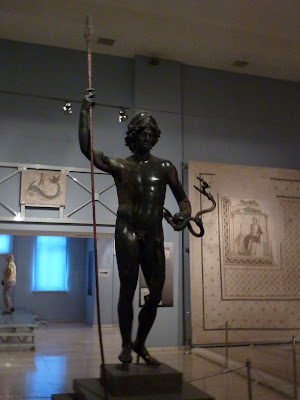Important PS: also in Gaziantep we found the wonderful Koluman Motorlu Araclar Ticaret ve Sanayi A. S., the local Mercedes Benz dealer, and a manager there who spoke excellent English, and had our engine oil/filters/etc., changed. Total cost was about $300. Compare this with $700 in Lisbon and $800 in Goteborg. So, we have resolved that, next time we need an oil change in Sweden, we will drive straightaway to Turkey.
 |
In the Gaziantep Archaeology Museum; we have seen this
pose before: Antiochos and Heracles, close personal buds |
 |
Closer up of a huge mosaic, the river god Okeanos and his wife Tethys, in a shallow
pool of a Roman villa at Zeugma, 2nd century |
 |
Detail; vibrant colors, not a tile missing
|
 |
Another room, showing the scale of this stuff
|
 |
Another; all these were floor mosaics
|
 |
Central panel of Euphrates River God mosaic, in a large room
|
 |
Geometrical
|
 |
Bronze Mars, found in an over-sized
amphora jar in Zeugma
|
 |
Zeugma as it appeared in the "rescue"
|
 |
And there she is
|















































.jpg)
